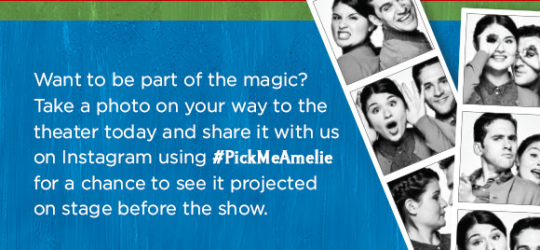By Adam Blair, Executive Editor

The new Broadway musical Amélie, based on the beloved 2001 movie starring Audrey Tautou, takes place in a long-ago, far-away place. Well not really that long ago — 1997 to be exact — or that far away (Paris). In some very important ways, though, this pre-smartphone era seems very remote from today.
A lot of the story depends on two important pieces of pre-smartphone technology: photo booths and pay phones. Before everyone carried around a combination phone and camera, these compact curtained booths provided you with four quick selfies for a dollar. And oh yes, pay phones — a place to make calls that couldn’t be tracked with Caller ID. Gen Z readers, ask your parents to explain.
Despite the low-tech vibe of the story, Amélie’s producers are using the most up-to-date technology, including user-generated social media, to create a sense of engagement with the theater audience. Theatergoers are given the opportunity to take a selfie before they even get to the theater, submit it with the #PickMeAmelie hashtag via Instagram, and to see their smiling face projected on the curtain before the show starts.

The ability to sell something that is quite old-fashioned and yet avail yourself of cutting-edge technology is one that a lot of retailers can, and should, take to heart. I got the email too late to participate (and I’m not on Instagram), but this struck me as a great way to bring the audience into the story even before the first note was sung.
Leveraging user-generated content to promote customer engagement certainly isn’t new, but it’s mostly been confined to online interactions. The Samsung 837 store in New York City’s Meatpacking District, which features an immersive tunnel that can be programmed to display a multitude of images from a shopper’s social media feed as he or she passes through, is a notable exception.
Amélie’s use of social media provides another lesson for retailers: use it organically. The fairy tale-style plot has Amélie, a shy, dream-struck young woman played beautifully in the musical by rising star Phillipa Soo, seeking ways to connect with other people. But her childhood (including hilariously disconnected and dysfunctional parents) means the only way she can do that is to anonymously perform good deeds for those around her, friends and strangers alike. (It sounds like it’s all too precious for words but I found it both charming and romantic.)
Retailers will want to ensure that their usage of social media and technology is organic as well. Certainly sharing one’s photo is not for every retailer, or every customer. I’m sure many people would not want to see their own picture showing up on a store’s digital signage while they shop — but a significant minority would probably get a kick out of it. Smart retailers could encourage such sharing with incentives and promotional contests.
At the very least, it would make the shopping experience more memorable, a key goal of experiential retail. And retailers would reap the benefit of a wealth of images, showing them not only who is shopping with them but their age, gender, and the types of clothes they wear.
Obviously, care would need to be taken so that consumers’ privacy is not violated. But it seems to me that the benefits outweigh the risks. Just as Amélie herself finally takes that big step toward actually connecting with another human being, retailers need to find new and innovative ways to reach out to their customers.






